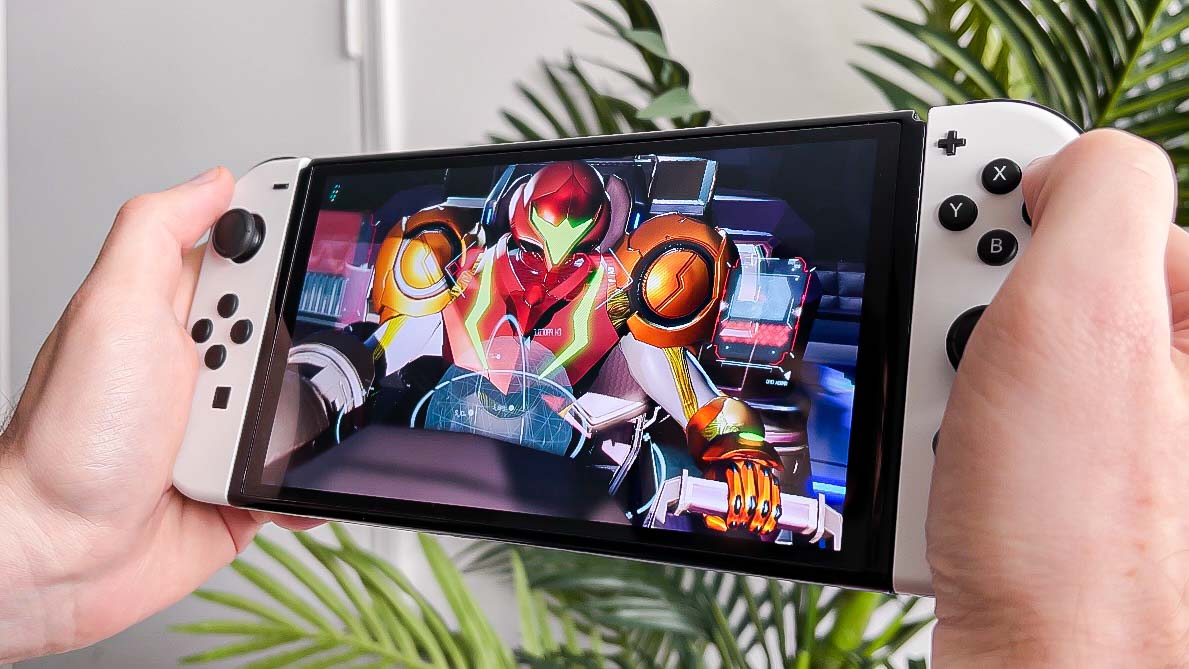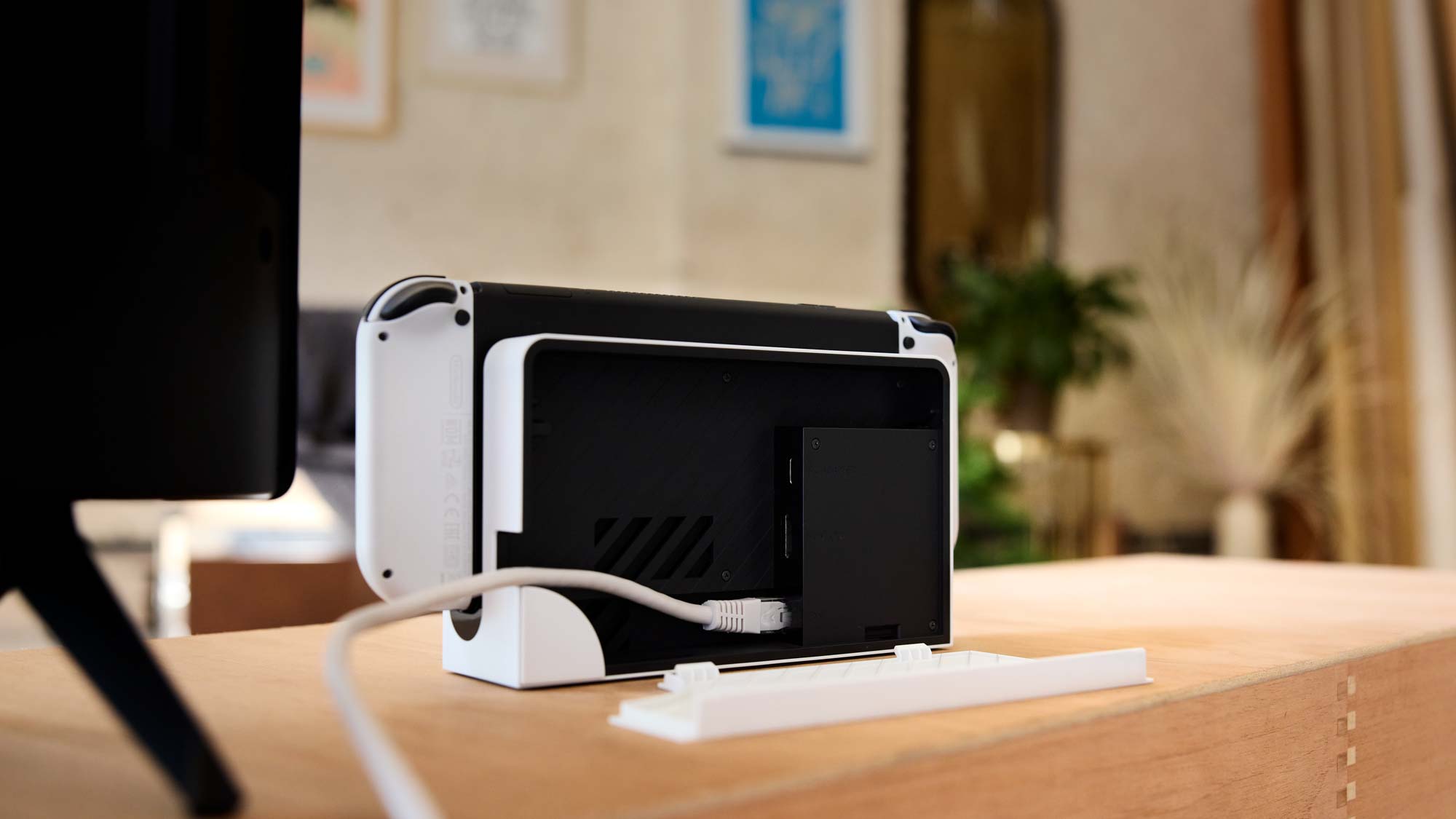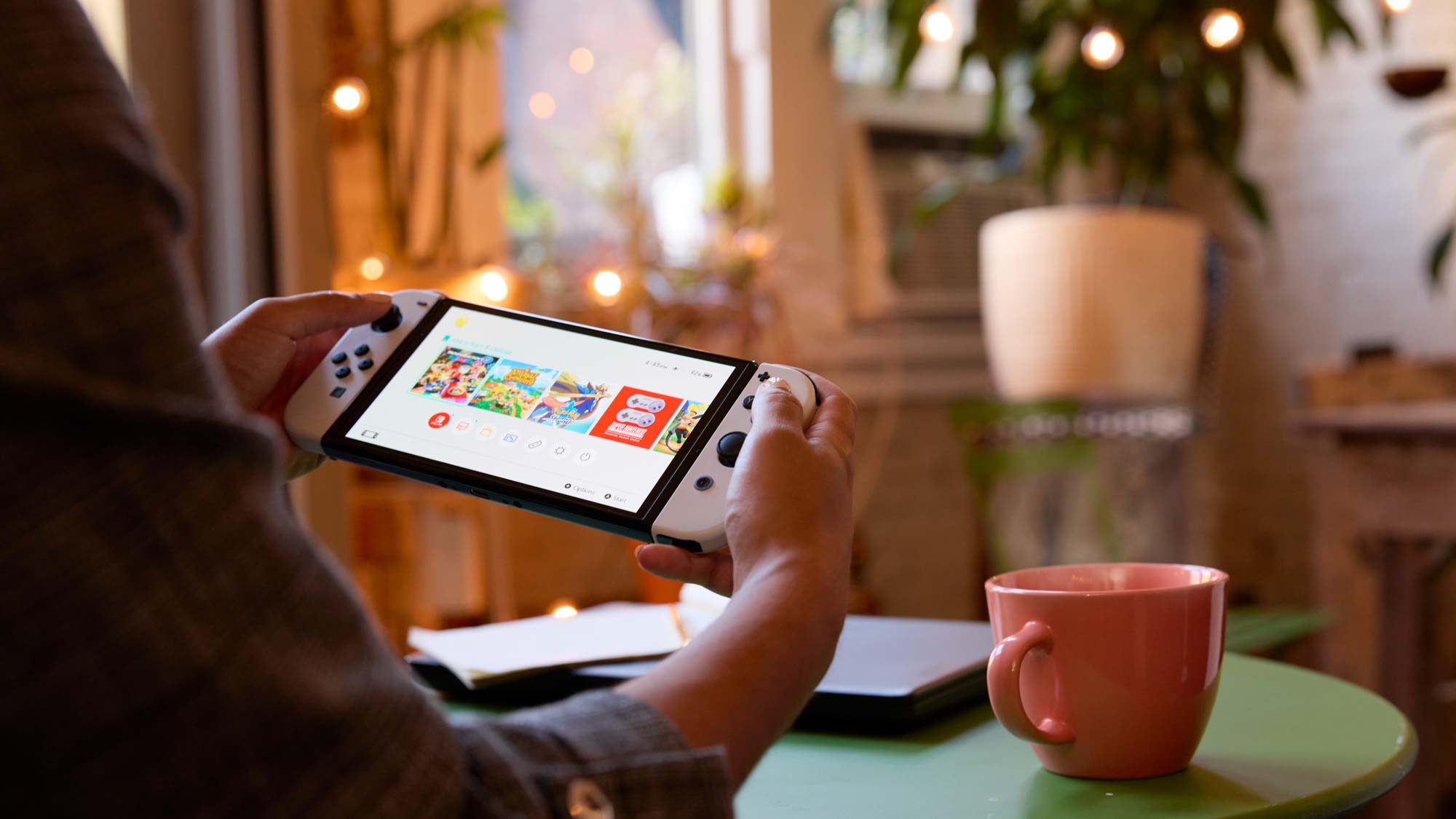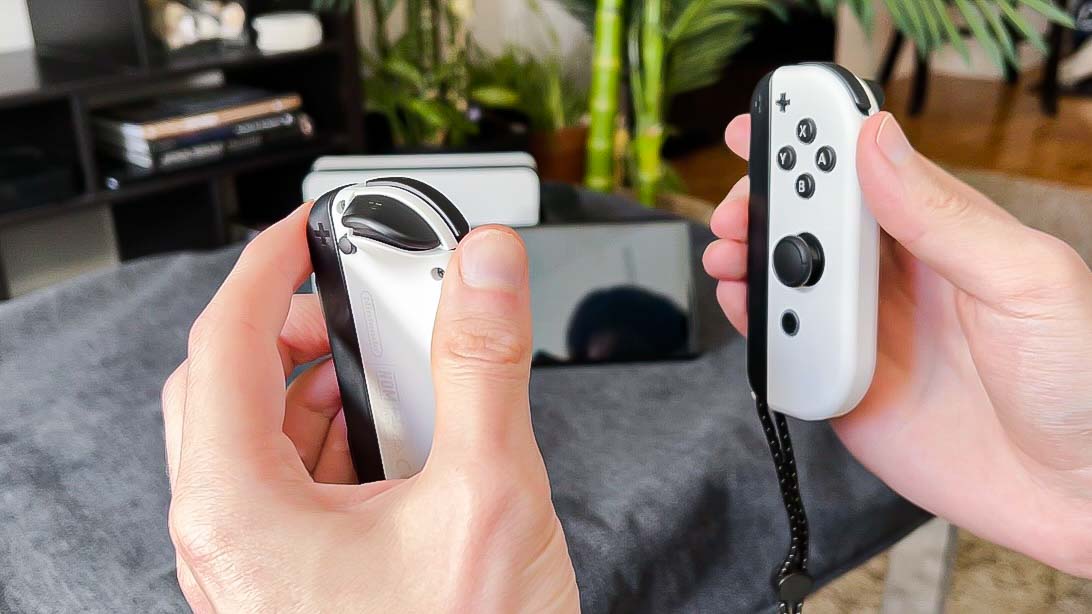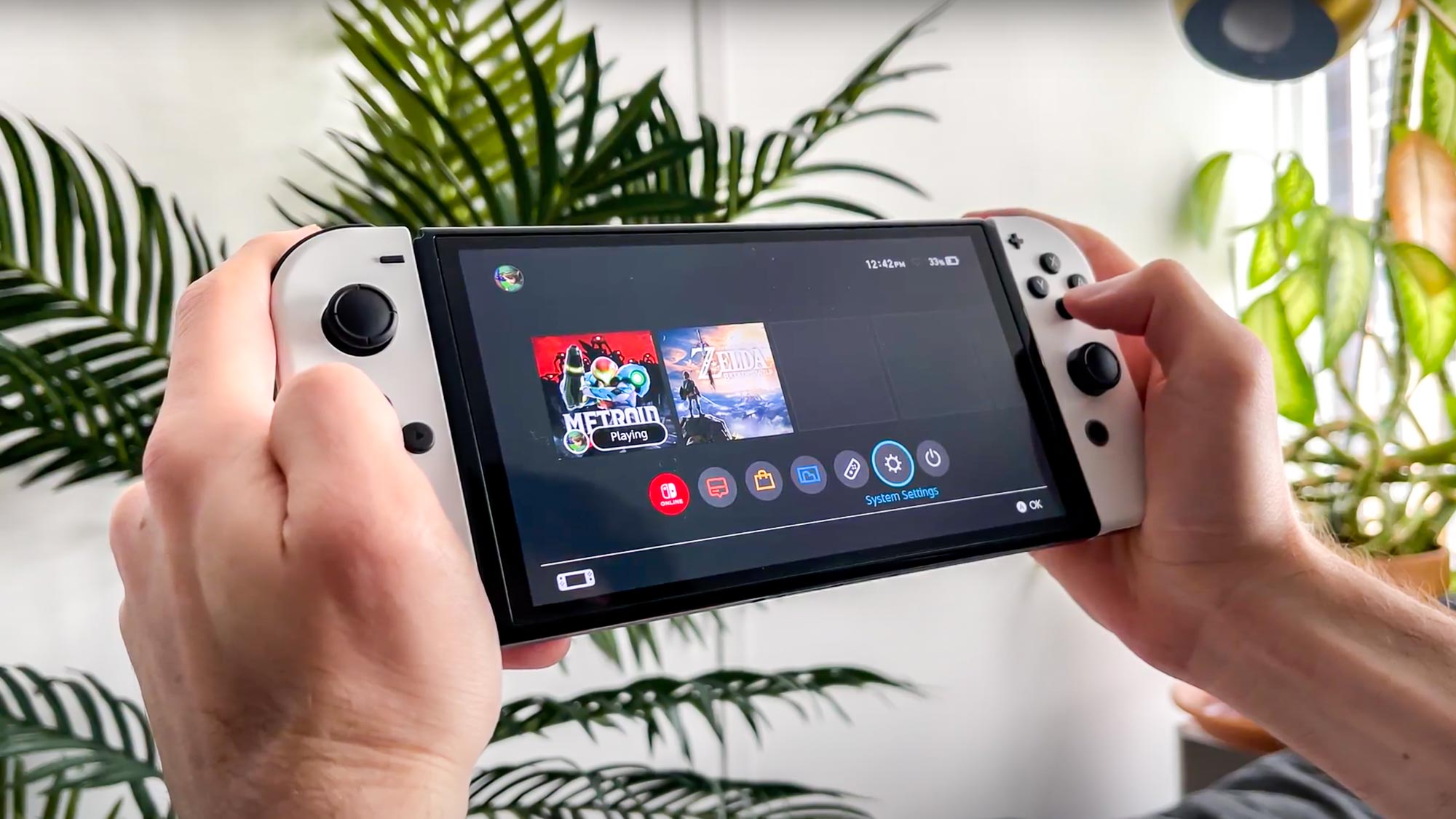Tom's Guide Verdict
The Nintendo Switch OLED sports a gorgeous screen, an improved kickstand and lots of storage space. It’s an easy recommendation for first-time Switch buyers — and an extravagance for current Switch owners.
Pros
- +
Beautiful OLED screen
- +
Handful of small, useful upgrades
- +
Handsome black-and-white color scheme
- +
Retains excellent Switch features and library
Cons
- -
No 4K capabilities
- -
Display still 720p
- -
Shows its age compared to PS5 and Xbox Series X/S
Why you can trust Tom's Guide
Release Date: October 8, 2021
Price: $350
Chipset: Custom Nvidia Tegra X1
Storage: 64 GB (expandable)
Display: 7-inch OLED
Max Resolution: 720p handheld/1080p docked
Max Framerate: 60 fps
Ports: USB-C, 3.5 mm audio, microSD, HDMI (docked), LAN (docked)
Size: 9.5 x 4.0 x 0.6 inches
Weight: 14.9 ounces (handheld)
Battery Life: 4.5 – 9 hours
If you are a newcomer to the Switch, then the Nintendo Switch OLED is the model to get. It's a mere $50 / AU$80 more than the original Switch, yet for $350 / AU$539.95 you get a notably improved display, as well as a few other quality-of-life tweaks, which promise to make for the best Switch gaming experience around.
The Switch OLED has the neat advantage of making the best Switch games look even better, thanks to its brighter and more vibrant display; if you have a modern Android smartphone or iPhone, take a glance at that, as it'll have an OLED display and you can get a taste of what to expect from the Switch OLED.
The caveat here is that if you already own an original Switch the upgrades on offer are probably not enough to buy the console again. It might be best to wait for the strongly-rumored Nintendo Switch 2 which could be revealed relatively soon.
Still, taken on its own merits, the Switch OLED is a strong machine. It still has a killer hybrid design, a terrific library of games and an admirable focus on gaming, first and foremost. If you’ve been on the fence about a Switch, the OLED is the model to get. Read on for our full Nintendo Switch OLED review — and once you've bought one, check out our Nintendo Switch OLED starter guide for tips on how to get the most from it and our most anticipated Nintendo Switch games for 2022 list.
Nintendo Switch OLED review: Design
First things first: The Nintendo Switch OLED is, for the most part, exactly like the console’s base model. If you want to know how the system functions overall, I recommend you check out our Nintendo Switch review, which covers the system’s general size and shape, portable functionality, idiosyncratic controllers, uneven online features and extensive game library.
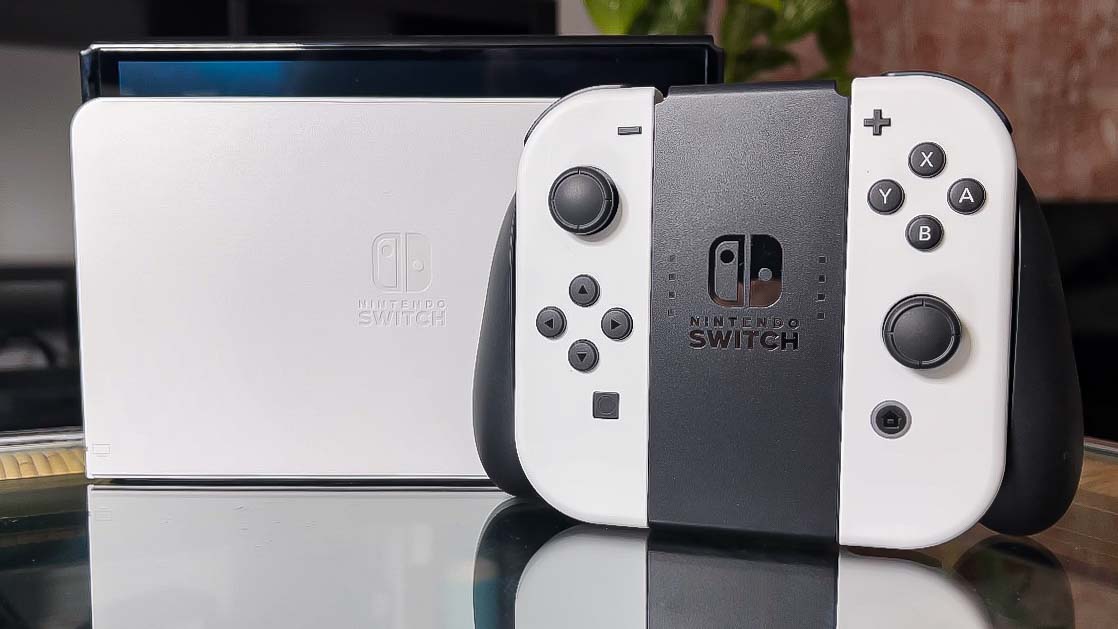
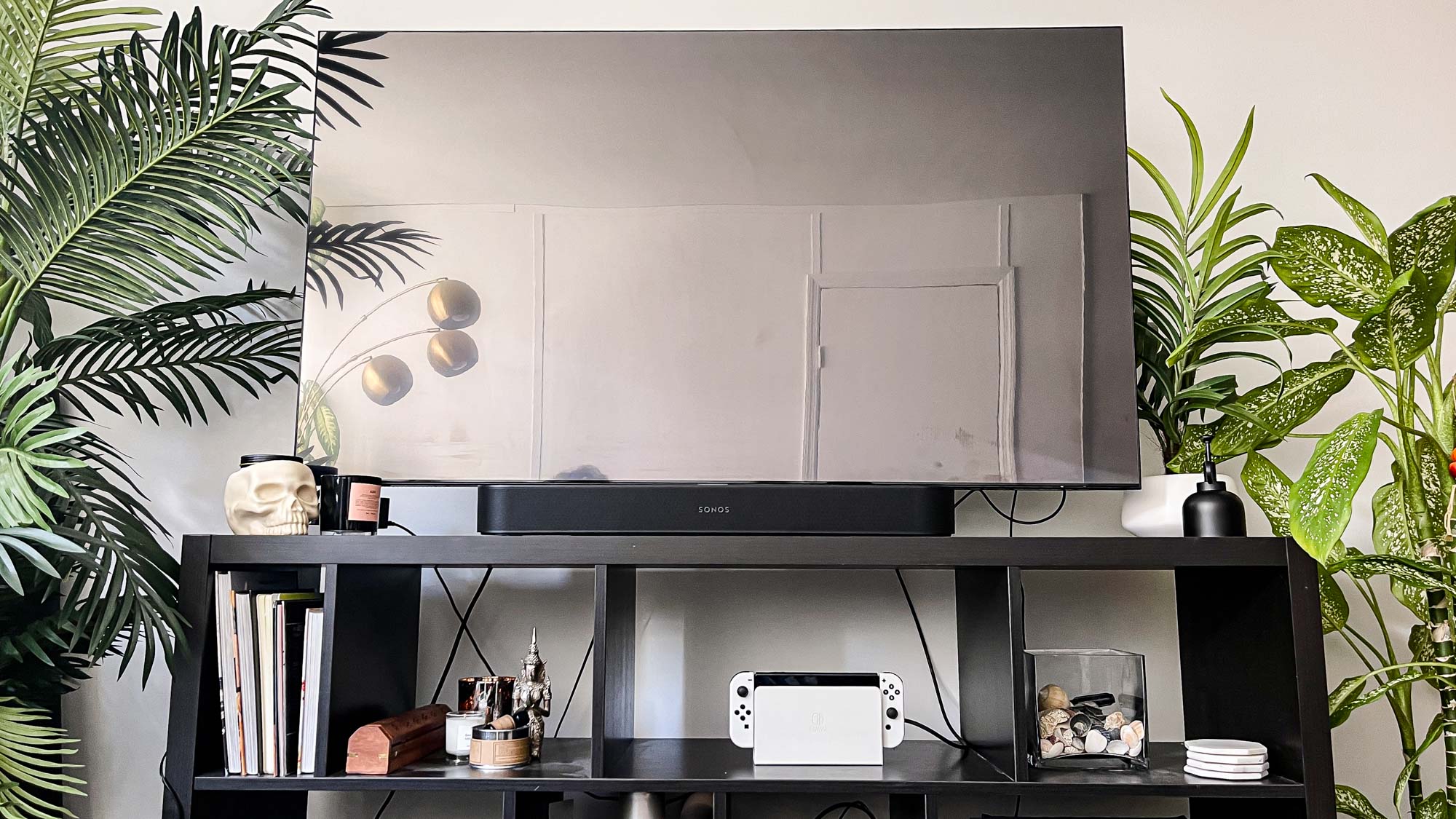
The first thing I noticed about the Switch OLED was that it’s the same size as the base Switch: 9.5 x 4.0 x 0.6 inches. This is a bit bigger than the handheld-only Nintendo Switch Lite, but it’s a comfortable size for most teens and adults to hold for long periods of time. (It’s probably a bit too big for small children.) This may seem like a minor point, but because the Switch OLED retains its counterpart’s physical design, all of your existing accessories should still work. Stashing the Switch OLED in my regular Switch’s carrying case saved me a big headache right off the bat.
To be fair, the Switch OLED is a tiny bit heavier than the base model: 14.9 ounces, as opposed to 14.1 ounces. I didn’t find the OLED less comfortable to hold for long periods of time, but when it comes to handhelds, lighter is better.
Get instant access to breaking news, the hottest reviews, great deals and helpful tips.
Nintendo Switch OLED review: OLED screen
From a physical standpoint, the Switch OLED makes two big deviations from the base model, and one small-but-significant deviation. The most noticeable change, of course, is the 7-inch OLED screen, compared to the 6-inch LCD screen on the base Switch.
The OLED screen is the centerpiece of the Switch OLED, and where most of Nintendo’s praise is due. The larger screen renders crisp images with vibrant colors and deep blacks. When you play a game with dark, detailed levels — such as the alien caverns of Metroid Dread or the foreboding castles of The Legend of Zelda: Breath of the Wild — the experience feels even more immersive than before. While the image quality isn’t vastly different between a 7-inch OLED and a 6-inch LCD, the color richness is.
When you play a game with dark, detailed levels — such as the alien caverns of Metroid Dread — the experience feels even more immersive than before.
At the same time, it’s worth pointing out that your eyes get acclimated to just about anything after a while. When I first jumped from the base Switch to the OLED model, I found the bigger screen and more lifelike colors stunning. After half an hour, I’d tuned them out to focus exclusively on gameplay. Likewise, going back to the base Switch felt like a big step down at first, and a nonissue shortly thereafter.
@tomsguide First look at new Nintendo Switch OLED ✨ #nintendoswitch #nintendo #nintendoswitcholed #oled #gaming #gamer #tech #review #consolegaming #fypシ
♬ chicken tikka - hannah
For this reason, among others, I’d caution existing Switch owners against running out to buy the OLED model. It looks good, but it’s not a night-and-day difference from what you already have. The screen still maxes out at 720p resolution; the console still chugs during demanding gameplay sections sometimes.
If you're worried about the Nintendo Switch OLED suffering from display burn in, don't be. A recent real-world test has found that it takes around 3600 hours of continual use for the console starts to showing even faint signs of ghosting.
Nintendo Switch OLED review: Kickstand and speakers
The Switch OLED’s other upgrades are more subtle, but still useful. The kickstand now runs the length of the device, rather than being a simple, flimsy piece of plastic. This makes it easier to stand the Switch OLED up on a variety of surfaces, without worrying about it taking a sudden dive.
Furthermore, the Switch OLED’s dock possesses a built-in Ethernet port, so you no longer have to buy a separate adapter.
Then there are the speakers, which don’t look much different, but sound considerably better. On the Switch OLED, the speakers are slightly bigger and have more of a rectangular shape.
The more important change, though, is that they sound much better than before, with a clearer, more nuanced soundscape, even at lower volumes. The ambient sound in Metroid Dread felt sufficiently ominous; the strong melody of the Hyrule Castle theme in The Legend of Zelda: Breath of the Wild felt sufficiently heroic.
Nintendo Switch OLED review: Interface
The Nintendo Switch OLED’s interface is exactly the same one you’ll find on the base Switch and Switch Lite with the same OS. That means that you’ll still get the easy-to-navigate game menu on the home screen, with separate sections for Nintendo Switch Online, news, the Nintendo eShop, saved photos and videos, controller options, brightness and other system settings.
The Switch OLED’s navigation is arguably not as robust as the PS5 or the Xbox Series X/S, but it’s also arguably much simpler and more straightforward. All Switch systems — including the OLED — now support Bluetooth audio, thanks to a recent firmware update, which is a nice touch.
Nintendo Switch OLED review: Performance
If there’s one area where the Switch OLED falls a bit short, it’s in performance. That’s not because the Switch OLED is any worse than the base model; in fact, it’s almost exactly the same. But the fact is that the Switch is a four-year-old console, and the industry has made some pretty significant strides in hardware since 2017. To put it bluntly, after playing the PS5 and Xbox Series X, it’s difficult to go back to a Switch, OLED or otherwise.
To put it bluntly, after playing the PS5 and Xbox Series X, it’s difficult to go back to a Switch, OLED or otherwise.
Like the base Switch, the Switch OLED features a custom Nvidia Tegra X1 chipset. This is similar to what’s inside a high-end streaming device; the Nvidia Shield uses one as well. The Switch OLED has 4 GB RAM and 64 GB flash storage. (The base model has 32 GB flash storage, so that’s improved, at least.) The result is a handheld hybrid that can display 720p at up to 60 frames per second in handheld mode, and 1080p at up to 60 fps in docked mode. 4K resolution and 120 fps frame rates are a pipe dream — not to mention the near-instantaneous loading times that SSDs can facilitate.
While Nintendo didn’t design the Switch to incorporate cutting-edge components, the device felt a little underpowered in 2017, and downright outmoded now. In handheld mode, you’ll notice long load times and low resolutions; in docked mode, you’ll notice dated graphics and inconsistent frame rates.
It’s also worth noting that if you own a base Switch and play primarily in docked mode, the Switch OLED has almost nothing to offer you. Once you plug the console into a dock, the OLED screen, larger kickstand and better speakers are meaningless. And if you need an Ethernet port, you can get a perfectly good adapter for $30.
The good news is that there is a way to get visuals from your Switch with an external accessory. We've tested the Marseille mClassic upscaler ($79 on Amazon) on games like Metroid Dread, and it does deliver cleaner, crisper graphics when using a larger 4K TV.
Nintendo Switch OLED review: Controller
Much like its interface and components, the Nintendo Switch OLED’s controller options are identical to those of the base Switch. The Joy-Cons are still competent when attached to the console, and a bit off-center and uncomfortable when plugged into the controller base.



They’re also great for impromptu multiplayer sessions. I still recommend the Nintendo Switch Pro Controller if you’re going to sit back and play games on the couch for hours on end.
This time around, you can get the Joy-Cons in either the traditional blue-and-red, or a stately black-and-white. I adore the Switch OLED’s new color scheme, but I do wonder how easily it will get dirty over time.
Nintendo Switch OLED review: Game library
The Nintendo Switch OLED offers a robust and eclectic game library, just like the base Switch and Switch Lite. The game selection is exactly the same among the three console variations. Just be aware that you’ll be able to play beloved first-party Nintendo fare, such as Breath of the Wild and Super Mario Odyssey, as well as more recent third-party hits, such as Doom (2016) and Dragon Ball FighterZ. The Switch OLED is also a fantastic place to play older games, from venerable classics like Mega Man X, to newer favorites like The Elder Scrolls V: Skyrim.
I would be remiss, however, if I did not mention Metroid Dread: the first original side-scrolling Metroid game in 19 years. Coming out alongside the Switch OLED, Metroid Dread is arguably the console’s flagship game. Samus Aran’s latest adventure does indeed look gorgeous on the OLED model, particularly the deep reds and blues of her power armor, and the stately blacks of the dangerous Planet ZDR. If you have any affinity for side-scrollers, Metroid Dread is among the best Nintendo Switch games, and therefore should be your first Switch OLED game purchase.
Nintendo Switch OLED review: Battery life
Nintendo claims that the Switch OLED can get between 4.5 and 9 hours of gameplay on a single charge, depending on which games you play. The Switch OLED employs the same battery as the base-model Switch, so the battery life may not be tremendously different. In our testing so far, Metroid Dread ate through a fully charged battery in about 5 hours, which is in line with Nintendo’s predictions.
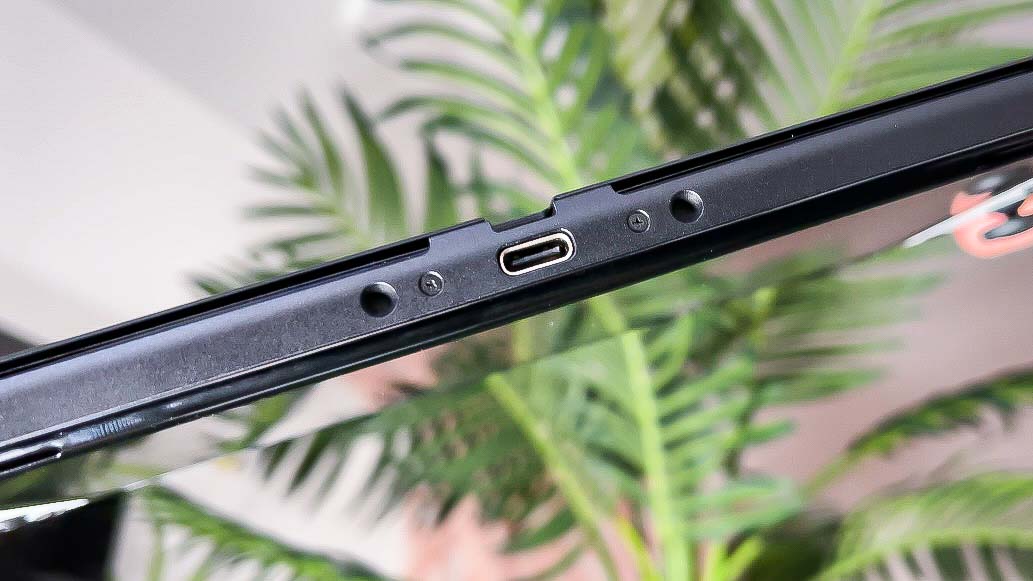
It's difficult to come up with a standardized gameplay test for the Nintendo Switch's battery life, as different gameplay activities tax the battery to different extents. Instead, we selected a colorful YouTube video with a lot of motion, then ran it on four different Switch models with the screen brightness at 100% and the volume at 50%. Here's how each Switch variant performed:
| Row 0 - Cell 0 | Nintendo Switch OLED | Nintendo Switch (2019 Model) | Nintendo Switch (Launch Model) | Nintendo Switch Lite |
| Battery Life (Hrs:Min) | 5:00 | 4:40 | 3:28 | 3:19 |
The Switch OLED performed just as Nintendo promised, offering a solid 5 hours of battery life. A launch model Switch provided 3 hours and 28 minutes, while a Switch Lite lasted for 3 hours and 19 minutes. Nintendo implemented a better battery in the base Switch in 2019; one of those models lasted 4 hours and 40 minutes on a single charge.
Nintendo Switch OLED review: Verdict
Overall, the Nintendo Switch OLED is a great system. This is primarily because the base Nintendo Switch is still a great system, and the Switch OLED makes a handful of smart additions. The OLED screen looks as impressive as we’d hoped. Smaller improvements to the kickstand, speakers, dock and storage also address shortcomings in the base model.
Still, there’s something decidedly unsatisfying about the Switch OLED. After four years, it still has the same components, the same resolution and the same controllers, none of which were perfect to begin with. With a whole new generation of consoles on the market, even an OLED screen can’t make the Switch feel particularly slick or powerful.
If you take it for what it is, the Switch OLED is a solid system, and an easy bet for gamers who haven’t taken the plunge on a Switch yet. But if you consider what it might have been, the Switch OLED may simply be a stopgap before Nintendo takes another big risk on another inventive idea.

Marshall Honorof was a senior editor for Tom's Guide, overseeing the site's coverage of gaming hardware and software. He comes from a science writing background, having studied paleomammalogy, biological anthropology, and the history of science and technology. After hours, you can find him practicing taekwondo or doing deep dives on classic sci-fi.


